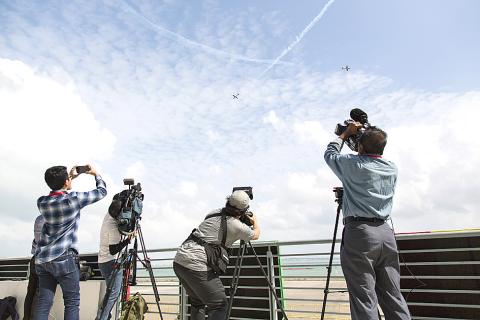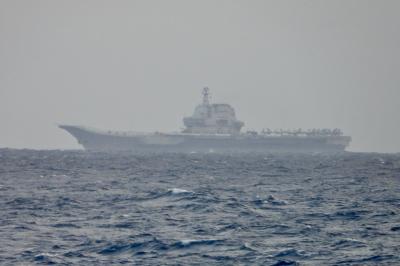The top US diplomat overseeing arms sales yesterday said she would promote US weaponry at the largest air show in Asia, where China’s military footprint and political influence are surging.
A large US delegation at the Singapore Air Show is doing “everything we can” to encourage Southeast Asian governments to purchase US-made arms such as the F-35 jet, Acting Assistant Secretary of State for Political-Military Affairs Tina Kaidanow told reporters in a telephone briefing.
She repeatedly sought to dispel the notion that US influence was in retreat.

Photo: Bloomberg
The administration of US President Donald Trump in December last year outlined a national security strategy that emphasized countering China’s rise. The strategy calls for reinforcing the US’ presence in the Indo-Pacific region, where Beijing and Washington have accused each other of stoking a dangerous military buildup while vying for influence.
Washington has been seeking to woo nations such as Vietnam with arms sales and transfers at a time when China has bolstered its territorial claims in the South China Sea.
Kaidanow said the transfer last year of a coast guard cutter to Vietnam, which often contests China’s maritime claims, was an “incredible positive.”
“They will be able to use our equipment for maritime domain awareness, for maritime security... That’s important for them,” said Kaidanow, who visited Hanoi last week shortly after US Secretary of Defense Jim Mattis, on a visit to Vietnam, announced plans to send an aircraft carrier to the nation in a show of solidarity.
“Our hope is they will consider American companies [not only] in defense, but in other sectors as well,” Kaidanow said.
Kaidanow said she would meet with officials from Japan, Canada and several Southeast Asian nations to discuss arms purchases at the trade show in the coming days and added that Southeast Asian countries should consider purchasing US arms “not just as a matter of security, but also regional balance.”
US warships are to maintain their freedom-of-navigation operations in South China Sea waters claimed by China, she said, adding: “We will absolutely continue the pace.”

AIR SUPPORT: The Ministry of National Defense thanked the US for the delivery, adding that it was an indicator of the White House’s commitment to the Taiwan Relations Act Deputy Minister of National Defense Po Horng-huei (柏鴻輝) and Representative to the US Alexander Yui on Friday attended a delivery ceremony for the first of Taiwan’s long-awaited 66 F-16C/D Block 70 jets at a Lockheed Martin Corp factory in Greenville, South Carolina. “We are so proud to be the global home of the F-16 and to support Taiwan’s air defense capabilities,” US Representative William Timmons wrote on X, alongside a photograph of Taiwanese and US officials at the event. The F-16C/D Block 70 jets Taiwan ordered have the same capabilities as aircraft that had been upgraded to F-16Vs. The batch of Lockheed Martin

GRIDLOCK: The National Fire Agency’s Special Search and Rescue team is on standby to travel to the countries to help out with the rescue effort A powerful earthquake rocked Myanmar and neighboring Thailand yesterday, killing at least three people in Bangkok and burying dozens when a high-rise building under construction collapsed. Footage shared on social media from Myanmar’s second-largest city showed widespread destruction, raising fears that many were trapped under the rubble or killed. The magnitude 7.7 earthquake, with an epicenter near Mandalay in Myanmar, struck at midday and was followed by a strong magnitude 6.4 aftershock. The extent of death, injury and destruction — especially in Myanmar, which is embroiled in a civil war and where information is tightly controlled at the best of times —

China's military today said it began joint army, navy and rocket force exercises around Taiwan to "serve as a stern warning and powerful deterrent against Taiwanese independence," calling President William Lai (賴清德) a "parasite." The exercises come after Lai called Beijing a "foreign hostile force" last month. More than 10 Chinese military ships approached close to Taiwan's 24 nautical mile (44.4km) contiguous zone this morning and Taiwan sent its own warships to respond, two senior Taiwanese officials said. Taiwan has not yet detected any live fire by the Chinese military so far, one of the officials said. The drills took place after US Secretary

THUGGISH BEHAVIOR: Encouraging people to report independence supporters is another intimidation tactic that threatens cross-strait peace, the state department said China setting up an online system for reporting “Taiwanese independence” advocates is an “irresponsible and reprehensible” act, a US government spokesperson said on Friday. “China’s call for private individuals to report on alleged ‘persecution or suppression’ by supposed ‘Taiwan independence henchmen and accomplices’ is irresponsible and reprehensible,” an unnamed US Department of State spokesperson told the Central News Agency in an e-mail. The move is part of Beijing’s “intimidation campaign” against Taiwan and its supporters, and is “threatening free speech around the world, destabilizing the Indo-Pacific region, and deliberately eroding the cross-strait status quo,” the spokesperson said. The Chinese Communist Party’s “threats